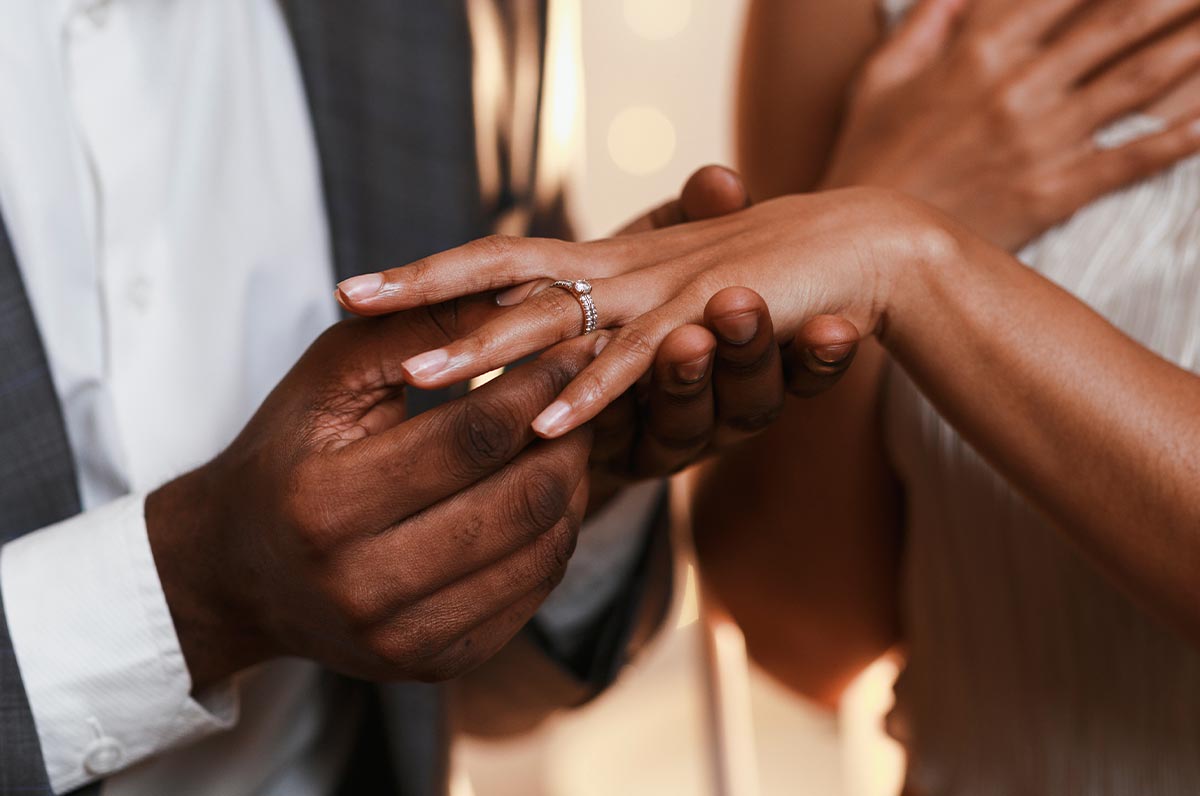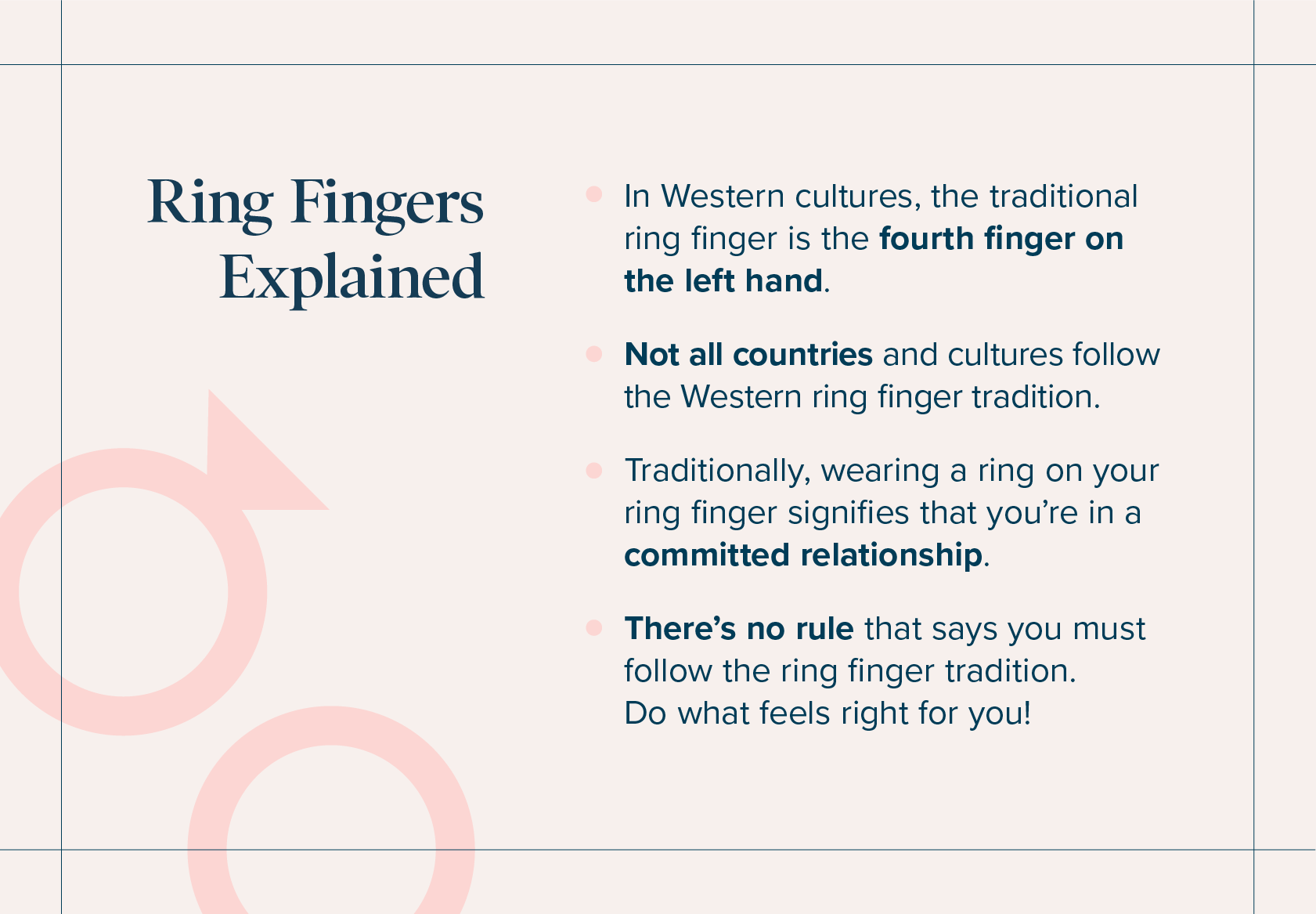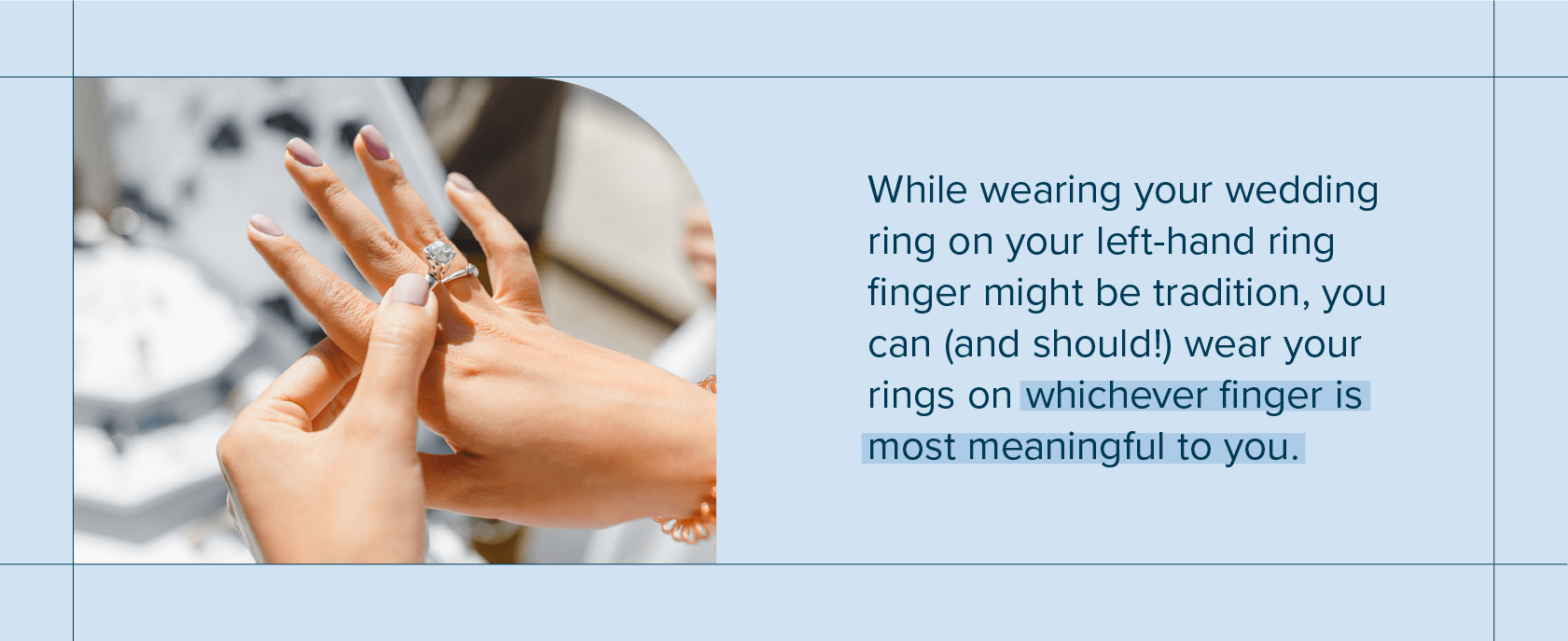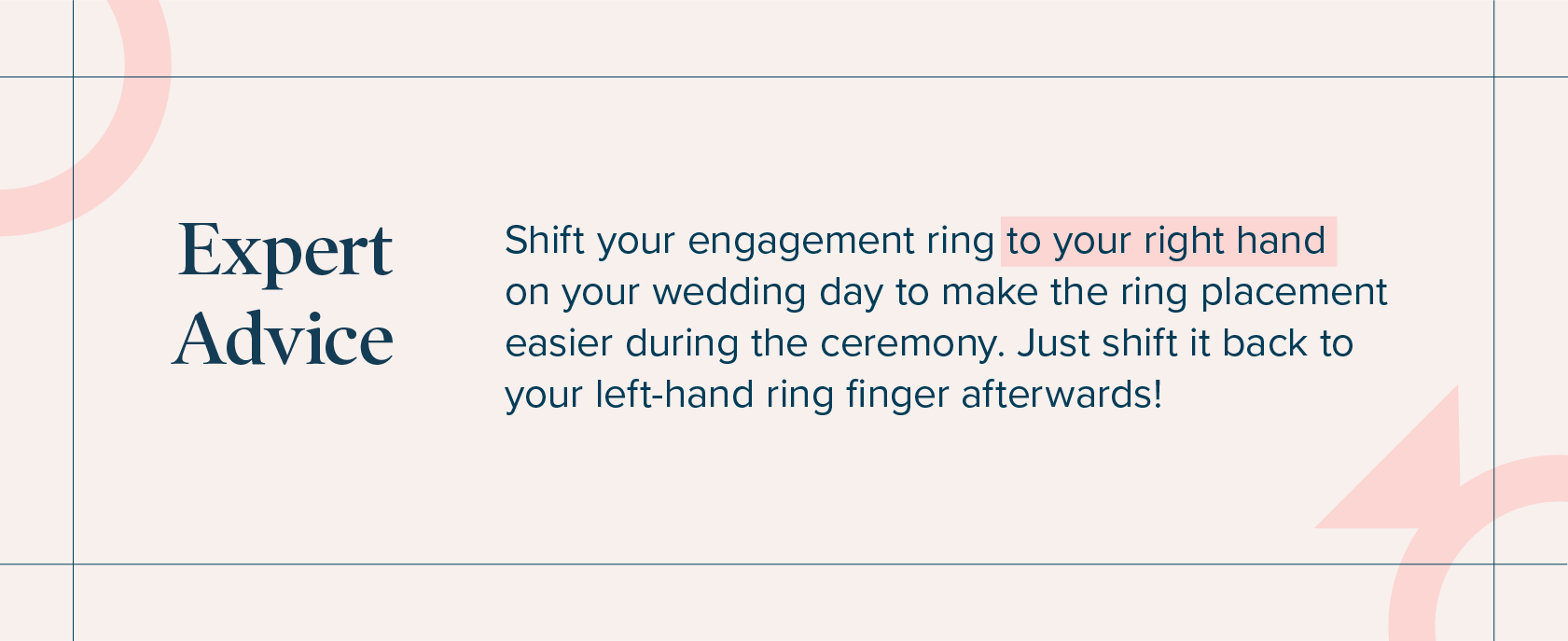- Expert advice/
- Getting engaged/
- Rings/
- Which Finger Does a Wedding Ring Go On?
- Rings
Which Finger Does a Wedding Ring Go On?
Ever wondered about the tradition behind wedding ring fingers? Here’s the real history and meaning of which finger a wedding ring goes on.
Last updated February 5, 2024

When it comes to wedding ring placement and which finger to wear a wedding ring on, traditions vary around the world. In many cultures, people wear their wedding ring on the fourth finger on the left hand—often called the “ring finger.”
But that’s certainly not true of all cultures. Let’s take a deep dive into everything you need to know about wedding ring fingers, including a bit of history behind this custom—as well as more information about wedding ring placement traditions around the world:

What Is the Significance of the Fourth Finger on the Left Hand?
Wedding rings were worn by ancient Egyptians on the left-hand ring finger from around 4000 B.C., a custom that was later adopted by early civilizations in ancient Rome and Greece. This fourth-finger tradition comes from the belief that this particular digit connected directly to the heart via a vein that early Romans referred to as the vena amoris, or vein of love. Eventually, the ring finger came to symbolize the connection of two newlyweds’ hearts (both brides and grooms) and their shared union of love.
Ancient Romans believed the ring finger had a vein that ran directly to the heart, known as the vena amoris, or vein of love.

Can I Wear My Wedding Ring on My Right Hand?
Short answer: Yes! While wearing your wedding ring on your left-hand ring finger might be tradition, there’s no rule that says you have to follow that tradition. Ultimately, the choice for your wedding finger comes down to personal preference. While wearing your wedding ring on your left-hand ring finger might be tradition, you can (and should!) wear your rings on whichever finger is most meaningful to you.

If you’re wondering about the meaning behind wearing your wedding ring on your right hand, the answer varies depending on different cultures and religions. While some early Romans adhered to the “vein of love” legend and placed the ring on the left hand, it’s also believed that some viewed the left hand as untrustworthy and unreliable, while the right hand symbolized honor and trust—thus, the wedding band was worn on the right hand.
Ancient legends aside, there are plenty of cultures today that wear wedding rings on the right hand. Again, it ultimately comes down to personal preference.
For example, wedding rings are more commonly worn on the right hand in certain Eastern European and Latin-American countries and in religions like Orthodox Christianity. In Jewish tradition and in other countries like Syria, Brazil, Turkey, and Lebanon, the wedding ring is worn on the right hand up until the wedding and transferred to the left hand after the ceremony. Ring Finger FAQs Which Finger Does a Promise Ring Go On? Traditionally given as an outward symbol of commitment to another person, promise rings are often worn on the ring finger (the fourth finger) of either hand. If worn on the left hand, it’s also common to move the promise ring to the right-hand ring finger after getting engaged. However, there’s no hard-and-fast rule—some people opt for the fourth-finger custom when it comes to their promise ring, while some choose to sport it on a different finger entirely.
Ring Finger Explained
In Western cultures, the traditional ring finger is the fourth finger on the left hand.
Not all countries follow the Western ring finger tradition.
Traditionally, wearing a ring on your ring finger signifies that you’re in a committed relationship.
There’s no rule that says you must follow the ring finger tradition. Do what feels right for you!
Other Wedding Ring Traditions Around the World
As mentioned, traditions around wedding ring placement by country and culture. Let’s take a look at wedding ring traditions of different countries around the globe:
-
Russia. In Russia, people traditionally wear wedding rings on their right hand—more specifically, on the ring finger of the right hand.
-
Germany. Germans also typically wear their wedding rings on their right-hand ring finger.
-
Norway. Norway is another country that embraces the tradition of wearing a wedding ring on the fourth finger of the right hand.
-
Austria. Austria borders Germany—and so it would make sense the two countries would share the tradition of wearing a wedding band on the ring finger of the right hand.
-
India. Traditionally, Indian culture viewed the left hand as unlucky and/or unsanitary. As such, wedding rings are traditionally worn on the right-hand ring finger.
Which Finger Does an Engagement Ring Go On?
In most Western countries, it’s tradition to wear an engagement ring on the fourth finger of the left hand. During the wedding ceremony, it’s common to shift the engagement ring to the right-hand ring finger once the wedding rings are exchanged—this stems from the tradition of wearing the wedding ring closest to the heart, but it also makes the wedding ring placement easier while the ceremony commences (just shift your engagement ring back to your left-hand ring finger after the ceremony!).

Expert Advice
Shift your engagement ring to your right hand on your wedding day to make ring placement easier during the ceremony. Just shift it back to your left-hand ring afterward!
Can I Stack My Engagement Ring and Wedding Ring?
Definitely! If you’ve chosen to wear your engagement and wedding rings on the same finger, stacking is a popular way to sport them. How you stack them is up to you. If you want to follow the tradition of wearing your wedding ring closest to your heart, you’d place your wedding ring at the bottom of the stack toward the base of the knuckle. (If you’re concerned with your rings’ ability to stack neatly on top of each other, jewelers can help you get the right fit.)
To achieve this on your wedding day, it’s helpful to switch your engagement ring to your right hand before the ceremony—that way, your partner can easily slide the wedding ring on your left finger during the ring exchange. Top it off with your engagement ring afterward, and voila! You might also consider getting the two rings soldered together down the line to create a single stacked ring, if you like that look.
Can I Wear My Rings All the Time?
It might be tempting to keep your rings on all the time, but we recommend removing them occasionally—especially during certain activities—to avoid scratching the metal or clouding up the stone. Your day-to-day activities won’t harm your wedding rings, but here’s when you should remove them:
- When working heavily with your hands
- When working with harsh cleaning chemicals
- In the shower (certain products may cause cloudy buildup on your stone)
- While lifting weights
- In chlorine pools or hot tubs
- On the beach
- Before bed to avoid finger swelling
That said, there’s always the option to switch out your wedding ring for a silicone ring if you’d prefer to keep a ring on at all times. The silicone material stands up against tough environments and activities like those outlined above, and is a great work-around if you don’t want to part with your ring!
Can I Wear Rings on My Ring Finger if I’m Not Engaged or Married?
There’s no reason why you can’t wear rings on your ring finger, even if you aren’t engaged or married! Whether there’s a diamond ring you’ve been eyeing for a while or you simply like wearing rings on your left-hand ring finger, there’s no rule preventing you from doing so.
That being said, people may make assumptions based on the long-standing ring finger tradition, and wearing a ring on that finger could lead others to assume you’re in a committed relationship.
While ring finger traditions have long been held across the world, we like to remind couples that just because something is traditional doesn’t mean it’s right for everyone. You can choose to wear your rings on whichever fingers feel right to you—whether you’ve just said “I do” or not! If you have, Zola’s Expert Advice is here to help every step of the way, from custom invitations to building the perfect wedding website. Happy wedding planning!
- Expert advice/
- Getting engaged/
- Rings/
- Which Finger Does a Wedding Ring Go On?
Find even more wedding ideas, inspo, tips, and tricks
We’ve got wedding planning advice on everything from save the dates to wedding cakes.